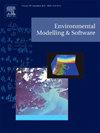DEM-based pluvial flood inundation modeling at a metropolitan scale
IF 4.8
2区 环境科学与生态学
Q1 COMPUTER SCIENCE, INTERDISCIPLINARY APPLICATIONS
引用次数: 0
Abstract
The global increase in urban flooding presents a substantial challenge that affects communities across the globe. This study introduces a post-flood inundation modeling framework tailored to pluvial floods on a metropolitan scale. We employ a dual drainage modeling approach for enhanced accuracy. The framework comprises two primary components: a Storm Water Management Model (SWMM) for simulating water movement within the storm drain system, and an advanced DEM-based flood inundation module that leverages SWMM results to predict flood inundation areas. Compared to the conventional flood spreading models commonly used in dual drainage modeling, this module incorporates high-resolution DEM cells into the surface flow routing processes, allowing to capture intricate surface terrain complexities. Additionally, the proposed module considers direct rainfall impacts on pluvial flood inundation mapping, resulting in enhanced accuracy. To evaluate the proposed model's accuracy, a two-step validation approach has been implemented. This includes comparing the proposed model results with both the high water marks measured in the aftermath of Hurricane Harvey and the flood depth map generated by a hydrodynamic model. The findings affirm the effectiveness of our proposed framework for post-flood inundation mapping within metropolitan settings. This method provides a dependable approach to urban flood modeling and represents an advancement in addressing the challenges associated with urban flooding.
基于 DEM 的大都市尺度冲积洪水淹没模型
全球城市洪水的增加带来了巨大的挑战,影响着全球各地的社区。本研究针对大都市规模的冲积洪水引入了洪水后淹没建模框架。我们采用了双重排水建模方法,以提高准确性。该框架由两个主要部分组成:一个是用于模拟雨水排放系统内水流运动的雨水管理模型(SWMM),另一个是基于 DEM 的先进洪水淹没模块,该模块利用雨水管理模型的结果来预测洪水淹没区域。与双排水系统建模中常用的传统洪水蔓延模型相比,该模块将高分辨率 DEM 单元纳入地表水流路由过程,从而捕捉到错综复杂的地表地形。此外,该模块还考虑了降雨对冲积洪水淹没区绘图的直接影响,从而提高了精度。为了评估拟议模型的准确性,采用了两步验证方法。其中包括将提议的模型结果与哈维飓风后测量到的高水位线以及水动力模型生成的洪水深度图进行比较。研究结果肯定了我们提出的框架在大都市环境中绘制洪水后淹没图的有效性。这种方法为城市洪水建模提供了一种可靠的方法,是应对城市洪水相关挑战的一个进步。
本文章由计算机程序翻译,如有差异,请以英文原文为准。
求助全文
约1分钟内获得全文
求助全文
来源期刊

Environmental Modelling & Software
工程技术-工程:环境
CiteScore
9.30
自引率
8.20%
发文量
241
审稿时长
60 days
期刊介绍:
Environmental Modelling & Software publishes contributions, in the form of research articles, reviews and short communications, on recent advances in environmental modelling and/or software. The aim is to improve our capacity to represent, understand, predict or manage the behaviour of environmental systems at all practical scales, and to communicate those improvements to a wide scientific and professional audience.
 求助内容:
求助内容: 应助结果提醒方式:
应助结果提醒方式:


